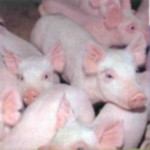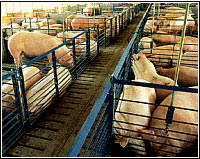|
We've all heard stories on the news about a "cat lady"—a woman who lives alone, except for the 78 cats who share her house. Most people's gut reaction to such a story is that it is not a particularly good situation for the cats. But let's play a little cat poker, up the ante, and throw some more chips into the kitty.
Instead of dozens of cats in the house, let's say it's 1,000 cats. And let's say that the carpeted floors have all been replaced with iron grates so the cat excrement can fall through and be efficiently hosed out. And just for good measure, let's install a system of iron bars to severely restrict each cat's movements even more that they are already constrained by the hyper-crowded kitty quarters. Finally, let's give the cats water through drip tubes and provide drug-laced food in a communal trough.
This is not cat Hell, it's a modern pig farm. Now, before you read any further, understand that
 this is not going to be an argument for you to give up pork products or turn vegetarian. Meatless diets are wonderful for those who choose them, but this article is going to deal only with our innate sense of knowing what's right and wrong when it comes to animal care—in this case, as it applies to the modern hog farm.
this is not going to be an argument for you to give up pork products or turn vegetarian. Meatless diets are wonderful for those who choose them, but this article is going to deal only with our innate sense of knowing what's right and wrong when it comes to animal care—in this case, as it applies to the modern hog farm.
Most of us have little concept of the conditions on a pig farm, but we certainly can imagine that nasty 1,000-cat house. As creatures, are hogs really so much different than cats that we can say it's acceptable to treat hogs in a manner that would prompt a call to the police if it were applied to cats?
Here are a few of the conditions that confront pigs on factory farms:
- Gestation crates — Two-foot-wide stalls in which pregnant sows are confined repeatedly for months at a time, with their movements severely restricted (e.g. insufficient room to turn around)
- Farrowing crate — Another movement-restriction device, this one designed to immobilize the sow while she is nursing her piglets
- Unnatural Flooring — Floors of wire mesh, metal grating, fiberglass, or concrete, with no bedding materials
- Snipped tails — Piglets' tails are cut off to reduce tail biting, which is caused in the first place by the stress of the cramped quarters
- Overuse of Antibiotics — These are required to keep animals healthy in overcrowded, stressful, non-natural environments
- Noxious atmosphere — Closed environments where the air contains ammonia, hydrogen sulfide, feed dust, and the gases from decomposing fecal matter
So, we must ask the question, is it OK to treat animals as so many parts in an assembly-line food-production machine? There's no getting around some level of nastiness associated with a slaughterhouse; after all, if we are going to eat ham, bacon and pork roast, the hogs must be slaughtered. The real question is, does the animal have a right to a decent form of existence while it is being raised? We think so.
On a recent broadcast of the farming-news show "US Farm Report," a spokesman for the hog industry was explaining
 how important animal care is to pork producers at the same time the pictures on the TV screen were showing piglets stumbling around on the iron-grated floors, separated from their sow mother and her milk-filled teats by a system of iron bars. The mother pig herself was constrained within a system of bars that made it difficult to move. The fact that the spokesman considers these and similar factory-farm conditions to be "proper care" for the animals illustrates the apparent level of delusion among most in the corporate hog-farming industry. (The standard industry response to criticism of restraint bars is that they keep the sow from rolling over on and crushing the piglets; but farmers who raise pigs in a natural, roomy environment will tell you that the sow's instincts make this a relatively rare occurrence.)
how important animal care is to pork producers at the same time the pictures on the TV screen were showing piglets stumbling around on the iron-grated floors, separated from their sow mother and her milk-filled teats by a system of iron bars. The mother pig herself was constrained within a system of bars that made it difficult to move. The fact that the spokesman considers these and similar factory-farm conditions to be "proper care" for the animals illustrates the apparent level of delusion among most in the corporate hog-farming industry. (The standard industry response to criticism of restraint bars is that they keep the sow from rolling over on and crushing the piglets; but farmers who raise pigs in a natural, roomy environment will tell you that the sow's instincts make this a relatively rare occurrence.)
Many consumers may think such conditions are unacceptable but feel far-removed from the problem and unable to see how they could effect change. But we don't have to accept this sadistic way of raising hogs. The more voices that complain about the conditions, the more likely the industry is to change.
You can also vote with your wallet by buying organic meats, which come from animals that are typically raised in better conditions, or you can look for the "Certified Humane" label on packages of meat. If your grocery store doesn't carry such products, they may start doing so if you ask them to. The good news is, hogs raised under non-stressful conditions are renowned for the wonderful taste of their meat.
For those who don't have access to such specialty meats, you can still have an impact by making minor shifts in your diet and thus sending fewer of your food dollars to the industrial meat industry. If you eat meat two or three times a day, consider changing one of your meat meals to a vegetable-protein-based meal.
 Protein sources such as soy, black beans, lentils, seeds, and nuts, when combined with grains, make excellent protein sources, give you added nutrients that aren't found in meat, and eliminate some of the bad things you ingest when you eat meat, such as cholesterol and saturated fat.
Protein sources such as soy, black beans, lentils, seeds, and nuts, when combined with grains, make excellent protein sources, give you added nutrients that aren't found in meat, and eliminate some of the bad things you ingest when you eat meat, such as cholesterol and saturated fat.
Hog Heaven is definitely not a modern hog farm. No one expects squeals of delight from animals we're raising for food, but we also should not expect treatment that is based on the blueprint of Dr. Moreau's House of a Thousand Cats.
Resources:
More articles and resources on....
Get Grinning Planet free via email
|


